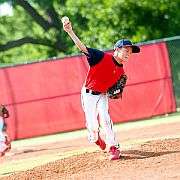Young pitchers often pressured to play despite pain, study says

(HealthDay)—Young baseball players feel pressure from parents or coaches to continue playing despite arm pain, and many parents are unaware of guidelines to reduce injury risk, a pair of recent studies found.
"Kids are playing harder and longer in more leagues than ever before," said Dr. Paul Saluan, director of pediatric and adolescent sports medicine at the Cleveland Clinic. "Kids also are not getting enough rest in between episodes of pitching, which may lead to insufficient time to heal smaller stress injuries. Over time, these smaller injuries add up."
The studies are scheduled for presentation March 24 at the American Academy of Orthopaedic Surgeons' annual meeting in Las Vegas. Data and conclusions presented at meetings are usually considered preliminary until published in a peer-reviewed medical journal.
The co-author of one of the studies explained how players feel. "Players who experience pain often felt their parents and coaches were frustrated with them," said Dr. Christopher Ahmad, professor of orthopedic surgery at Columbia University Medical Center in New York City.
"Throwing with pain is a signal that injury is occurring," added Ahmad, who is the New York Yankees' head team physician.
In Ahmad's study, he and his colleagues surveyed 203 healthy players, aged 8 to 18. Just under one-quarter of them had experienced a prior overuse injury, they found.
Almost half of the players—46 percent—said they had been encouraged to continue playing with arm pain, and 30 percent said their arm pain sometimes made playing less fun.
Those most likely to report being encouraged to play despite pain had a previous overuse injury. They were also more likely to report feeling arm pain while throwing and to experience arm fatigue during games or practice.
For the second study, researchers surveyed 60 parents of baseball pitchers, aged 9 to 18. They found just over half of parents were not aware of safe pitching guidelines and did not actively monitor their child's pitch count.
The most important aspects of safe pitching guidelines are a maximum number of recommended throws based on a child's age and the number of days of rest needed between throwing stints, said Saluan.
"The focus has been on creating a better athlete who can throw harder, faster and more accurately than ever before," Saluan said. "Injury prevention has taken a back seat."
One in five parents did not know how many pitches their child threw in a typical game, but 64 percent recalled that their child had experienced pain in the upper extremities because of pitching, the survey found. For one-third of the pitchers, the pain required a medical evaluation.
"Kids who continue to pitch through pain end up with significant injuries that may have lifelong consequences," Saluan said. "Younger pitchers who are still growing are much more vulnerable than adults to sustain an injury to the growth plates around the shoulder and elbow."
Growth plates are the cartilage areas at the end of long bones in children's and teens' bodies, which allow the bones to grow until they turn into solid bone in adulthood, he said. But until then, this cartilage is a "weak point" that is sensitive to the repeated stresses caused by pitching.
Injuries to the growth plates usually heal with rest, Ahmad said. But he noted that more young pitchers are also damaging their ulnar collateral ligament, an important ligament in the elbow.
"Unfortunately, these injuries do not always heal and often require surgery," he said.
The main causes of these injuries are specialization in playing and too much throwing without enough rest, Ahmad said. Other factors include training like adult players, playing year-round, playing on multiple teams at once, poor pitching mechanics, throwing at high velocity and throwing in showcases to impress a scout, pro team or coaches.
In the pitching study, half the young pitchers threw in at least two leagues at a time, one-quarter pitched more than nine months of the year, and just over half participated in extra showcase situations.
"We have fallen into the trap of 'too much too soon,'" said Saluan. "This has resulted in a rise in injury rates in kids whose bodies are not prepared to handle the stresses that are encountered."
More information: The Nemours Foundation has more on preventing kids' baseball injuries.
Copyright © 2015 HealthDay. All rights reserved.













